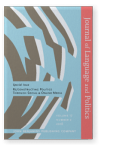Microphone pokes as prank or political action?
Challenges to politicians’ visibility in the age of web TV
The production of political talk is changing in response to ongoing changes in the overall media ecology. The rise of web TV
challenges the previously dominant mediated politics of traditional broadcasting. In this paper we examine the practices of the
mediatization of politics in the web TV environment via a humorous encounter between a self-declared “prankster” posing as a web
TV broadcaster, and several Swedish politicians. The discussion reflects on various data emanating from this encounter to reveal
how Web TV challenges traditional broadcasting norms, and offers fresh challenges for politicians who are continuously adapting to
new media logics for exposure.
Article outline
- 1.Introduction
- 2.Mediated interviews as communicative activity types
- 3.Methodological approach and data
- 4.Analysis
- 4.1Example 1: Prioritizing Live: Expressen’s filming of STHLM Panda
- 4.2Example 2: Re-framing the Web TV Interviews – The Panda YouTube video
- 4.3Example 3: Discourses of Humour, Ridicule, and Rage among Users
- 5.Discussion and conclusion
- Funding
-
References
